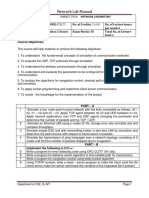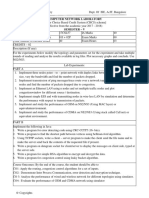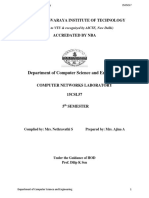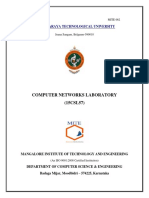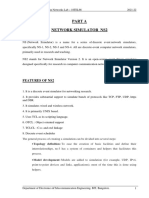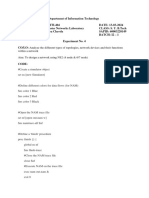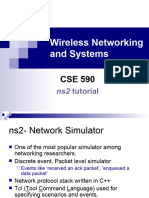0% found this document useful (1 vote)
393 views32 pagesComputer Networks Lab Guide
This laboratory experiment involves simulating computer networks using various networking tools. It contains 6 parts:
Part A involves simulating networks using tools like NS2, NS3, OPNET, etc. and implementing experiments like:
1) A 4 node point-to-point network to analyze performance by varying bandwidth and queue size.
2) A 4 node network applying TCP and UDP to determine packets sent by each.
3) An Ethernet LAN of 6-10 nodes to compare throughput by changing error rate and data rate.
Part B involves programming experiments in C/C++ like:
1) Implementing HDLC frame bit and character stuffing.
2) Implementing distance vector and D
Uploaded by
Kiran kdCopyright
© © All Rights Reserved
We take content rights seriously. If you suspect this is your content, claim it here.
Available Formats
Download as PDF, TXT or read online on Scribd
0% found this document useful (1 vote)
393 views32 pagesComputer Networks Lab Guide
This laboratory experiment involves simulating computer networks using various networking tools. It contains 6 parts:
Part A involves simulating networks using tools like NS2, NS3, OPNET, etc. and implementing experiments like:
1) A 4 node point-to-point network to analyze performance by varying bandwidth and queue size.
2) A 4 node network applying TCP and UDP to determine packets sent by each.
3) An Ethernet LAN of 6-10 nodes to compare throughput by changing error rate and data rate.
Part B involves programming experiments in C/C++ like:
1) Implementing HDLC frame bit and character stuffing.
2) Implementing distance vector and D
Uploaded by
Kiran kdCopyright
© © All Rights Reserved
We take content rights seriously. If you suspect this is your content, claim it here.
Available Formats
Download as PDF, TXT or read online on Scribd
/ 32

